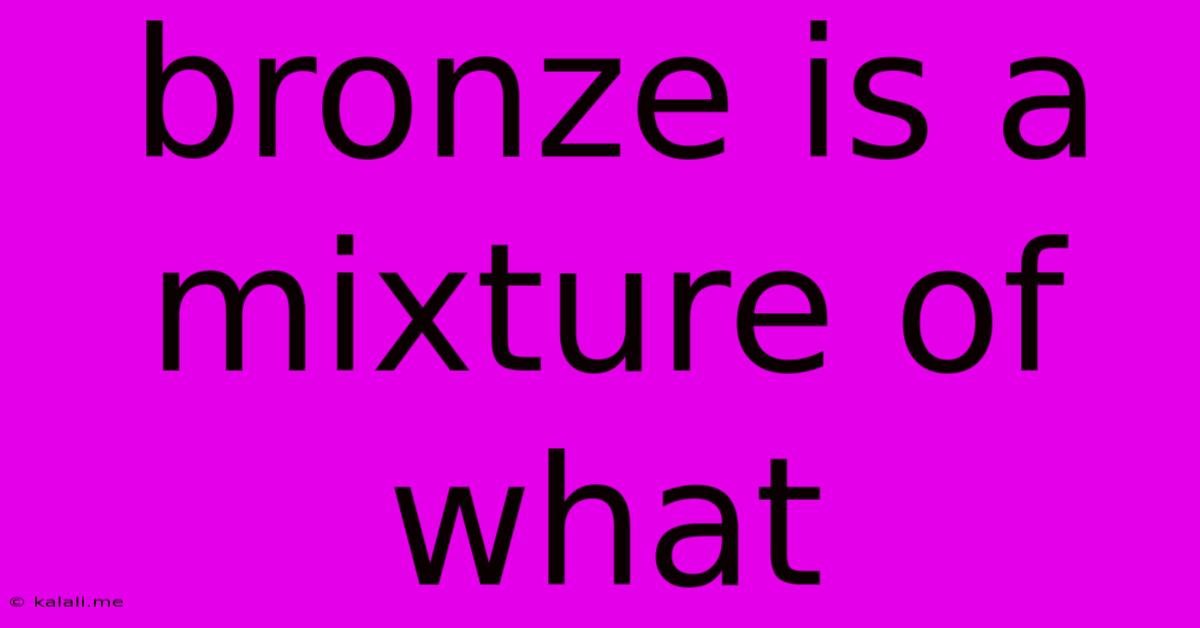Bronze Is A Mixture Of What
Kalali
Jun 14, 2025 · 3 min read

Table of Contents
Bronze: A Mixture of Copper and Tin (and Sometimes More!)
Bronze, a significant material in human history, isn't a single element but an alloy. This means it's a mixture of two or more metals, creating a material with properties superior to its constituent parts. Understanding what bronze is a mixture of opens up a fascinating world of metallurgy and historical advancements. This article will explore the primary components of bronze, delve into variations in its composition, and highlight the reasons for its widespread use throughout history.
The Primary Components: Copper and Tin
The fundamental components of bronze are copper and tin. The ratio of these two metals determines the final properties of the bronze. Typically, bronze contains 6% to 20% tin, with the remaining percentage being copper. This relatively simple mixture resulted in a material significantly harder and stronger than pure copper, making it ideal for a wide array of applications. The exact percentage of tin influences the resulting bronze's hardness, melting point, and durability. Higher tin content generally results in harder but more brittle bronze, while lower tin content leads to softer but more malleable bronze.
Beyond the Basics: Other Additives in Bronze Alloys
While copper and tin are the defining elements, other metals can be added to bronze to further enhance its properties. These additions are often referred to as alloying agents and can significantly impact the final characteristics. Some common additives include:
- Zinc: Adding zinc can increase the bronze's strength and fluidity, making it easier to cast. This results in what is sometimes called brass bronze or even just brass if the zinc percentage is high enough.
- Lead: Lead's addition improves the bronze's machinability, making it easier to work with. However, this can also reduce its overall strength and durability.
- Aluminum: Adding aluminum enhances the bronze's strength and corrosion resistance. Aluminum bronze is known for its exceptional toughness and wear resistance.
- Manganese: This additive improves the bronze's tensile strength and hardness.
- Nickel: Nickel additions enhance the corrosion resistance and strength of the bronze, particularly in saltwater environments.
These alloying additions allowed ancient and modern metallurgists to tailor the properties of bronze to specific applications, from intricate jewelry to powerful weapons. The specific composition chosen reflected the desired properties and the availability of raw materials.
The Significance of Bronze in History
The discovery of bronze marked a significant turning point in human civilization. This alloy's superior properties over copper allowed for the creation of stronger and more durable tools, weapons, and implements. The Bronze Age, characterized by the widespread use of bronze tools and weaponry, witnessed significant advancements in agriculture, warfare, and societal organization. This period saw the development of more sophisticated technologies and a rise in complex civilizations.
Understanding Bronze's Composition: A Key to its Success
The versatility of bronze, owing to its variable composition, facilitated its prominent role in shaping human civilization. By carefully controlling the ratios of copper and tin (and other added elements), metallurgists could fine-tune the bronze's characteristics to fit diverse applications. This ability to manipulate material properties made bronze a cornerstone of technological advancement for centuries. Understanding the precise mixtures involved sheds light on both the material science and the ingenuity of ancient artisans and modern metallurgists alike.
Latest Posts
Latest Posts
-
Which Of The Following Secrete Hydrochloric Acid
Jun 14, 2025
-
The Total Number Of Lobes In Both Lungs Is
Jun 14, 2025
-
Which Of The Following Is Not Associated With Animal Cells
Jun 14, 2025
-
What Are The Prime Factors Of 14
Jun 14, 2025
-
What Is The First Step In Respiration
Jun 14, 2025
Related Post
Thank you for visiting our website which covers about Bronze Is A Mixture Of What . We hope the information provided has been useful to you. Feel free to contact us if you have any questions or need further assistance. See you next time and don't miss to bookmark.